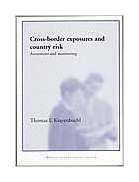|
||
• wydawnictwa polskie
• Zamów informacje o nowościach z wybranego tematu • kontakt
• Cookies na stronie |
CROSS-BORDER EXPOSURES AND COUNTRY RISKKRAYENBUEHL T.wydawnictwo: WOODHEAD , rok wydania 2001, wydanie Icena netto: Cross-border exposures and country riskThe definitive study of this important topic its purpose, practice and implications The international financial system has come under strain several times in recent years, and analysis has shown that most crises originated from the risks built into cross-border exposures. Assessment and monitoring of cross-border exposures and country risk are essential activities for international lending agencies such as government bodies, banks, multinational corporations and other investors. Inadequate risk management could have a destabilising effect on both lender and borrower and could result in a major international financial crisis. This new and completely revised edition of Thomas E Krayenbuehl's classic handbook clearly shows how the various players can quantify and manage the complex factors involved in order to minimise the risk and avoid potentially catastrophic consequences. It provides both a rigorous analysis of the current situation and a guide to meeting the challenges of the future. Just some of the things you'll discover... How to succeed in cross-border lending and investment through good assessment, monitoring and hedging of country risk How the Tequila and Asian crises came about, and the lessons learned The likelihood of future crises and the potential causes The latest problems to beset the international financial system The recent developments in cross-border financing Why the problem of contagion occurs between seemingly unrelated markets The enormous need for global capital to bring about sustainable economic development in the developing world, and the role of the major players in fulfilling it The numerous factors that constitute and influence a specific country risk The responsibilities of all the parties involved, from the IMF and the World Bank to the industrialised and developing nations, the regulators and the rating agencies How this study helps you This lucid and authoritative handbook will help you to: About the authorAfter graduating as a Doctor of Law in 1961, Thomas E Krayenbuehl began a career that has involved him in banking and financial control and management in the USA, Switzerland and Germany. In 1998 he retired from Union Bank of Switzerland, now UBS AG. At UBS his responsibilities were always associated with business development and risk management in the developing world. He is now an independent consultant working for, among others, the International Finance Corporation in Washington and the Swiss Government on projects in the developing world. Contents1. Overview Introduction The debt crisis of the 1980s The Brady Plan The Tequila crisis The Asian crisis The latest problems Heavily indebted poor countries recent developments in cross-border financing Conclusions References 2. The need for capital Introduction The borrowers Gross domestic investment Capital needs Domestic funds Cross-border funds Conclusions References 3. Risks in cross-border exposures and their assessment Introduction Transfer risk Factors in influencing cross border foreign exchange flows Political risk Relating transfer and political risk References 4. Monitoring of cross-border exposures and hedging of currency risks Introduction The establishment of country limits Monitoring cross-border exposures The change of country risk quality and its consequences Hedging of country risk The case of contagion Outsourcing risk assessment The rating agencies Conclusions References 5. Responsibilities Introduction The International Monetary Fund (IMF) The World Bank Group The regional multilateral financial institutions The industrialized countries The developing countries The regulators The rating agencies Conclusions References 6. Conclusions Annex 1: Glossary Annex 2: Articles of Agreement of the International Monetary Fund, Article IV Annex 3: Selected sovereign ratings for foreign currencies of developing countries Annex 4.1: Country risk rating by The International Country Risk Guide Annex 4.2: Country risk rating by the International Investor Annex 4.3: Country risk rating by Euromoney Annex 5: Alternative exchange rate regimes 224 pages Księgarnia nie działa. Nie odpowiadamy na pytania i nie realizujemy zamówien. Do odwolania !. |


